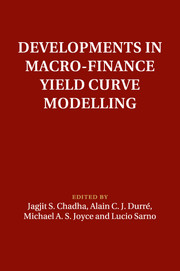Book contents
- Frontmatter
- Contents
- List of figures
- List of tables
- List of contributors
- Foreword
- Preface
- 1 Editors' introductory chapter and overview
- Part I Keynote addresses
- Part II New techniques
- Part III Policy
- Part IV Estimating inflation risk
- 13 Inflation compensation and inflation risk premia in the euro area term structure of interest rates
- 14 The predictive content of the yield curve for inflation
- 15 Inflation risk preminum and the term structure of macroeconmic announcements in the euro area and the United States
- Part V Default risk
- Index
14 - The predictive content of the yield curve for inflation
from Part IV - Estimating inflation risk
Published online by Cambridge University Press: 05 February 2014
- Frontmatter
- Contents
- List of figures
- List of tables
- List of contributors
- Foreword
- Preface
- 1 Editors' introductory chapter and overview
- Part I Keynote addresses
- Part II New techniques
- Part III Policy
- Part IV Estimating inflation risk
- 13 Inflation compensation and inflation risk premia in the euro area term structure of interest rates
- 14 The predictive content of the yield curve for inflation
- 15 Inflation risk preminum and the term structure of macroeconmic announcements in the euro area and the United States
- Part V Default risk
- Index
Summary
14.1 Introduction
It is hard to overestimate the importance of inflation forecasting. Since most prices are sticky and a number of contracts imply long-term commitments in nominal terms, forward-looking economic agents tend to have implicitly in their decision-making process some form of forecasting of the general price level in the economy. For example, the prediction of inflation guides firms and employees during the negotiation of labour contracts, and influences investors in the evaluation of asset prices. This central role of inflation expectations in the economy also creates a man-date for central banks to achieve predictable (and low) inflation rates. Therefore, inflation forecasting is also important from a central banking perspective; inflation projections typically serve as an important element in the monetary policy decision process.
Notwithstanding the importance of inflation forecasting, it has been difficult to develop satisfactory forecasting models that generate both accurate and timely inflation forecasts. The significant publication lags of crucial information variables limit the use of various model-based or survey-based approaches and have introduced market-based alternatives. The latter circumvent the issue of publication lags by limiting the information set to observable financial variables and hence have the potential to provide timely inflation forecasts. Examples of this approach include the well-known breakeven inflation rate or, more recently, the use of inflation swaps. However, the success of the latter approach crucially hinges on the dominance of the expectations component in the time variation of the derived measures.
- Type
- Chapter
- Information
- Developments in Macro-Finance Yield Curve Modelling , pp. 390 - 411Publisher: Cambridge University PressPrint publication year: 2014

